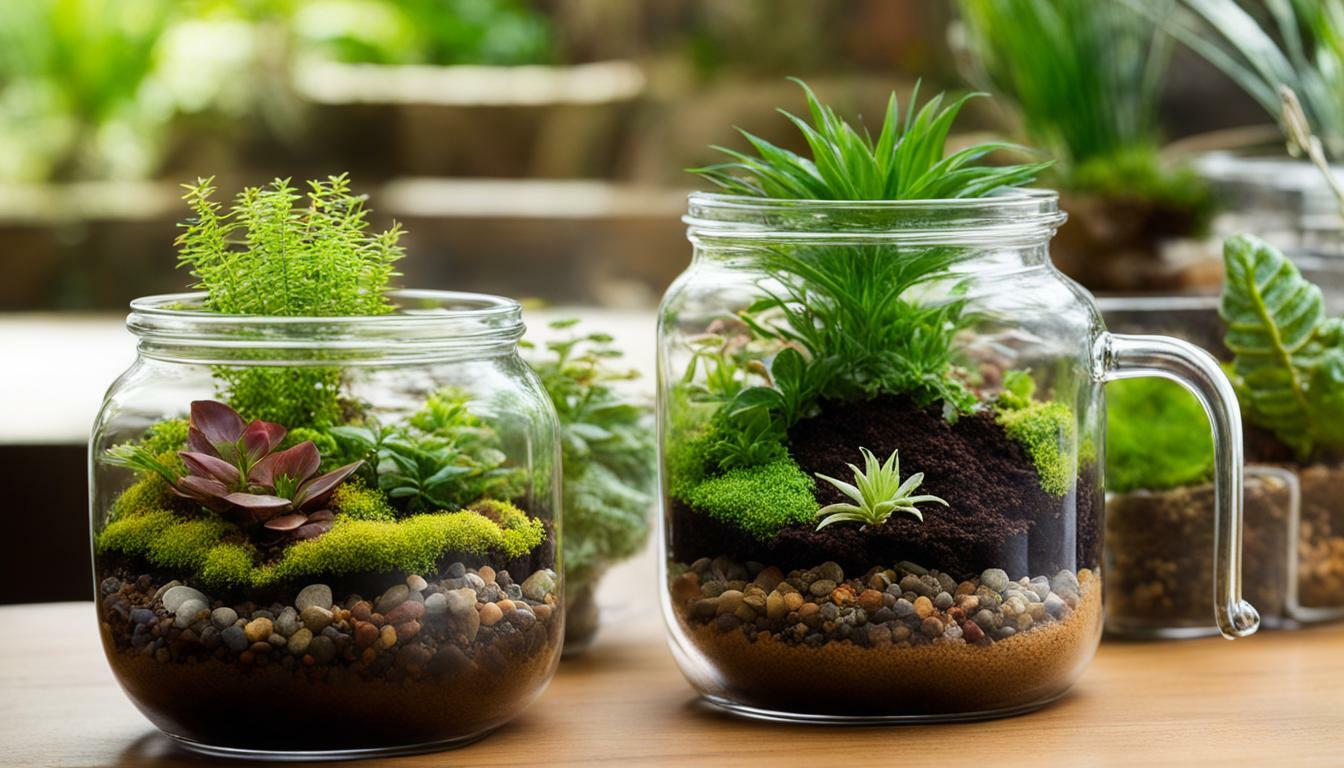Understanding Terrarium Soil Types
The choice of soil type is important in creating an optimal environment for terrarium plants to grow. Different terrarium soil types provide varying levels of moisture retention, drainage, and nutrient content, which directly impact the health and growth of your plants. Let’s explore the different terrarium soil ingredients and their characteristics.
Table 1: Terrarium Soil Types and Their Characteristics
| Soil Type | Characteristics |
|---|---|
| Sphagnum Peat Moss | Retains moisture well, promotes root growth |
| Perlite | Improves drainage, prevents waterlogging |
| Vermiculite | Retains moisture, provides aeration |
| Potting Soil | Rich in nutrients, drains well |
It is essential to create a balanced terrarium soil mix that incorporates a combination of these soil types to provide adequate moisture, drainage, and nutrient levels. By understanding the characteristics of each soil ingredient, you can tailor your mix to suit the specific needs of your terrarium plants.
Understanding Terrarium Soil Types
In addition to the soil types mentioned above, there are other options such as coco coir, sand, and orchid bark that can be used to enhance specific properties of the soil mix. Experimentation and adjusting the soil composition based on the specific requirements of your plants will lead to optimal growth and health of your terrarium.
Remember, maintaining the right balance of moisture and pH levels in your terrarium soil is crucial. Regularly monitor the soil moisture and adjust watering accordingly to prevent overhydration or dehydration of your plants. By providing the correct terrarium soil type and composition, you are setting the foundation for thriving and beautiful terrarium plants.
Best Types of Soil for Terrariums
Selecting the best soil for your terrarium is essential for providing the right nutrients and moisture retention for your plants. Different terrarium plants have varying soil requirements, so it’s important to choose the appropriate soil mix to promote healthy growth.
When creating a terrarium soil mix, it’s recommended to use a combination of ingredients that provide good drainage, moisture retention, and aeration. A common terrarium soil mix consists of a combination of potting soil, sand, and peat moss.
Terrarium Soil Mix Recipe:
| Ingredient | Amount |
|---|---|
| Potting Soil | 60% |
| Sand | 20% |
| Peat Moss | 20% |
Potting soil acts as the base for the terrarium mix, providing essential nutrients for plant growth. Sand helps with drainage and prevents the soil from becoming waterlogged, while peat moss retains moisture and adds acidity to the soil, which is beneficial for certain plant species.
It’s important to note that not all terrarium plants have the same soil preferences. Succulents, for example, require a well-draining soil mix to prevent root rot, so a higher proportion of sand should be used. Research the specific needs of your terrarium plants and adjust the soil mix accordingly.
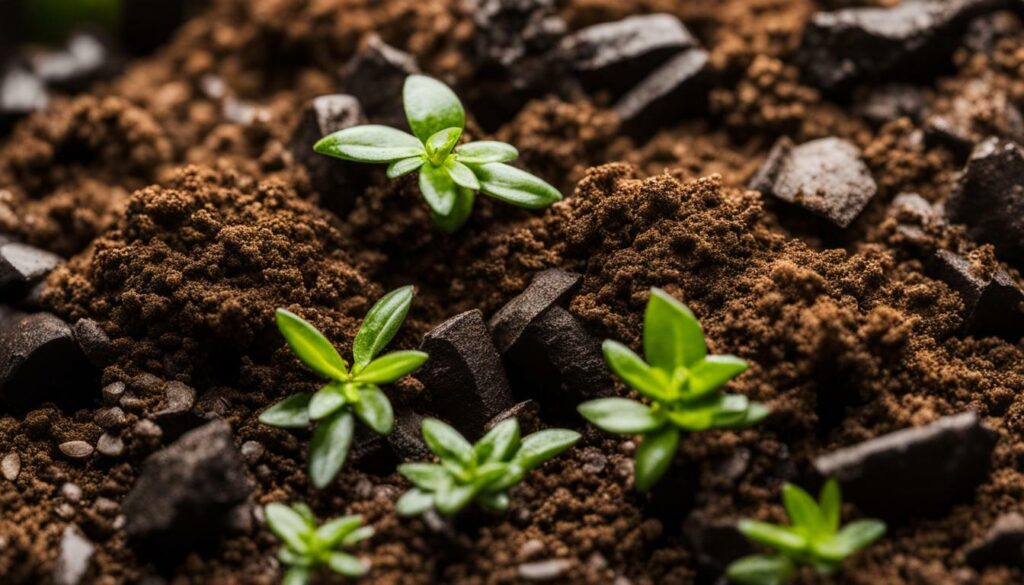
Keep in mind that terrariums create a more humid environment, so it’s important to use a soil mix that can retain moisture without becoming waterlogged. Regular monitoring of the soil’s moisture levels is necessary to ensure your plants receive the right amount of water.
With the right soil mix, your terrarium plants will thrive and create a beautiful, self-sustaining ecosystem. Experiment with different soil ratios and ingredients to find the perfect balance for your terrarium’s unique needs.
Understanding Terrarium Soil Composition
Understanding the composition of terrarium soil and ensuring proper drainage is crucial for the overall well-being of your terrarium plants. The right soil composition provides essential nutrients and supports healthy root development, while proper drainage prevents waterlogged conditions that can lead to root rot and other plant issues. Let’s explore the key components of terrarium soil composition and how to create a well-draining environment for your plants.
When it comes to terrarium soil, a blend of different materials is often used to create the ideal composition. These materials typically include a mix of potting soil, peat moss, sand, and perlite. Potting soil provides a nutrient-rich base, while peat moss helps retain moisture. Sand and perlite are added to improve drainage and prevent soil compaction.
It’s important to strike the right balance when mixing these ingredients. Aim for a soil mixture that is well-draining yet retains enough moisture for the plants to thrive. A good rule of thumb is to use equal parts potting soil and peat moss, with a smaller amount of sand and perlite mixed in. This combination allows for adequate drainage while still providing enough moisture retention.
To further enhance drainage, you can place a layer of rocks or pebbles at the bottom of your terrarium before adding the soil. This will create a reservoir for excess water to collect, preventing it from saturating the soil and drowning the roots. Additionally, ensure that your terrarium has adequate ventilation to allow for proper air circulation, which helps prevent excessive moisture buildup.
Suggested Terrarium Soil Composition:
| Ingredient | Proportion |
|---|---|
| Potting Soil | 1 part |
| Peat Moss | 1 part |
| Sand | 1/4 part |
| Perlite | 1/4 part |
By understanding the composition of terrarium soil and ensuring proper drainage, you can create a thriving environment for your terrarium plants. Remember to monitor the moisture levels, adjust watering accordingly, and perform regular maintenance to keep your terrarium healthy and visually appealing.
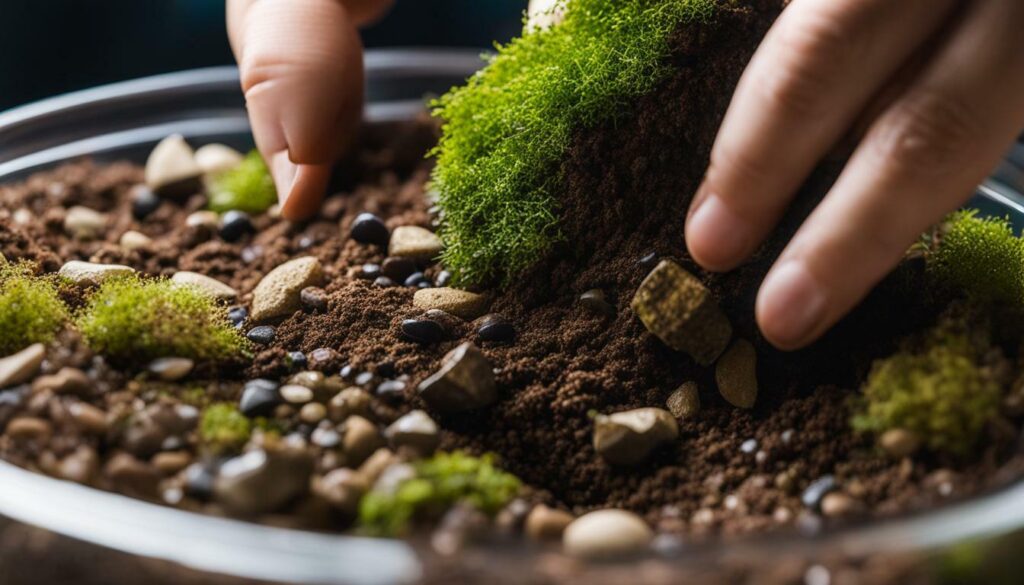 Maintaining the right moisture levels in your terrarium soil is crucial for the overall health and growth of your plants. Too much moisture can lead to root rot and other fungal issues, while too little moisture can result in wilting and stunted growth. By following a few simple guidelines, you can ensure that your terrarium soil retains the perfect amount of moisture for your plants to thrive.Firstly, it’s important to choose the right type of soil for your terrarium. Opt for a well-draining soil mix that allows excess water to flow through and prevents waterlogged conditions. A mix of potting soil, sand, and perlite is often recommended for terrariums. This combination not only provides proper drainage but also helps to retain some moisture for the plants.In addition to the soil mix, regular monitoring of the moisture levels is essential. Stick your finger about an inch into the soil to check for moisture. If it feels dry, it’s time to water your terrarium. However, if the soil feels wet or damp, hold off on watering until it has dried out a bit. Remember, every terrarium is unique, and the watering needs may vary depending on factors such as the size of the container and the types of plants you have.To maintain the correct moisture levels, you can mist the terrarium with a spray bottle filled with water. This method allows you to control the amount of moisture added without overwatering the soil. Alternatively, you can water the plants from the bottom by placing the terrarium pot in a dish of water for a short period, allowing the soil to soak up the moisture. Be sure to remove the terrarium from the water once the topsoil feels slightly damp.To keep track of the moisture levels more accurately, you can use a moisture meter. This handy tool measures the moisture content of the soil, helping you determine when to water. Simply insert the moisture meter into the soil and follow the instructions provided with the device.By maintaining the right moisture levels in your terrarium soil, you are providing the ideal growing conditions for your plants. Remember to observe and adjust watering practices based on the needs of your terrarium and the plants within it. With proper moisture management, your terrarium will flourish and become a stunning, self-sustaining ecosystem.
Maintaining the right moisture levels in your terrarium soil is crucial for the overall health and growth of your plants. Too much moisture can lead to root rot and other fungal issues, while too little moisture can result in wilting and stunted growth. By following a few simple guidelines, you can ensure that your terrarium soil retains the perfect amount of moisture for your plants to thrive.Firstly, it’s important to choose the right type of soil for your terrarium. Opt for a well-draining soil mix that allows excess water to flow through and prevents waterlogged conditions. A mix of potting soil, sand, and perlite is often recommended for terrariums. This combination not only provides proper drainage but also helps to retain some moisture for the plants.In addition to the soil mix, regular monitoring of the moisture levels is essential. Stick your finger about an inch into the soil to check for moisture. If it feels dry, it’s time to water your terrarium. However, if the soil feels wet or damp, hold off on watering until it has dried out a bit. Remember, every terrarium is unique, and the watering needs may vary depending on factors such as the size of the container and the types of plants you have.To maintain the correct moisture levels, you can mist the terrarium with a spray bottle filled with water. This method allows you to control the amount of moisture added without overwatering the soil. Alternatively, you can water the plants from the bottom by placing the terrarium pot in a dish of water for a short period, allowing the soil to soak up the moisture. Be sure to remove the terrarium from the water once the topsoil feels slightly damp.To keep track of the moisture levels more accurately, you can use a moisture meter. This handy tool measures the moisture content of the soil, helping you determine when to water. Simply insert the moisture meter into the soil and follow the instructions provided with the device.By maintaining the right moisture levels in your terrarium soil, you are providing the ideal growing conditions for your plants. Remember to observe and adjust watering practices based on the needs of your terrarium and the plants within it. With proper moisture management, your terrarium will flourish and become a stunning, self-sustaining ecosystem.| Tips | Description |
|---|---|
| Choose a well-draining soil mix | Avoid waterlogged conditions and promote proper drainage by using a mix of potting soil, sand, and perlite. |
| Monitor soil moisture regularly | Check the moisture levels by sticking your finger about an inch into the soil. Only water when the soil feels dry. |
| Mist the terrarium with a spray bottle | Control the amount of moisture added by misting the terrarium with a spray bottle. Avoid overwatering the soil. |
| Water from the bottom | Alternatively, water the terrarium from the bottom by placing it in a dish of water for a short period. Remove from the water once the topsoil feels slightly damp. |
| Use a moisture meter | A moisture meter can provide more accurate readings of soil moisture levels. Follow the instructions provided with the device. |
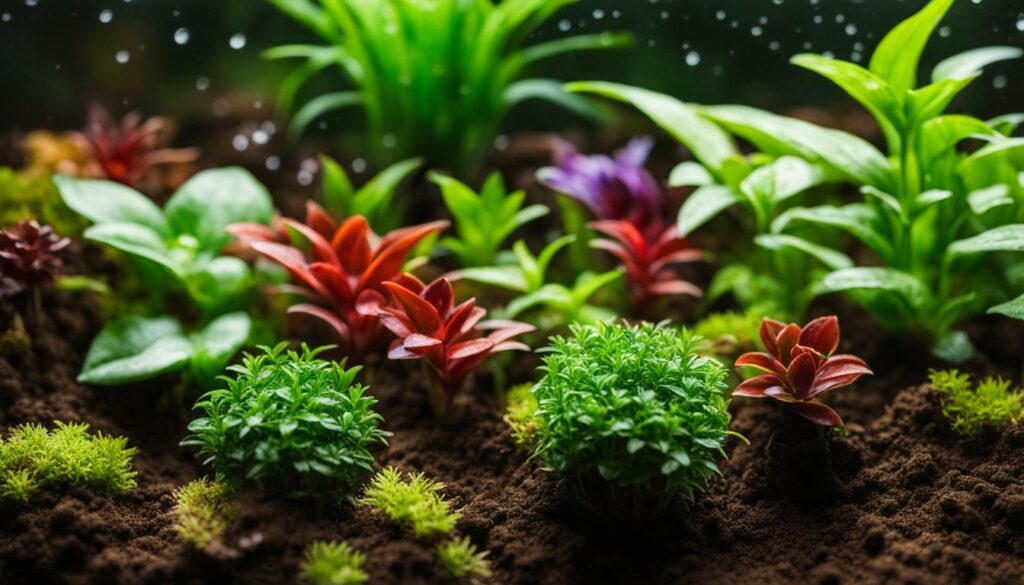
Mold and fungus can pose a threat to the health of your terrarium plants, but with the right soil care and drainage, you can effectively manage and prevent their growth. Terrarium soil care involves maintaining the proper moisture levels and ensuring adequate drainage. Excessive moisture can create a favorable environment for mold and fungus to thrive, so it’s essential to strike a balance.
One way to prevent mold and fungus is to use a well-draining terrarium soil mix. This type of soil allows excess water to drain away, minimizing the risk of moisture buildup. Good drainage helps to discourage mold and fungus growth, as these organisms thrive in damp conditions. Adding materials like perlite or crushed charcoal to the soil mix can enhance drainage.
Regularly monitoring the moisture levels of your terrarium soil is crucial. It’s important to water your plants sparingly, as overwatering can lead to excessive moisture and encourage the growth of mold and fungus. Allow the top inch of soil to dry out before watering again. Additionally, it’s essential to provide proper airflow within the terrarium to prevent stagnation and excess humidity.
| Preventing Mold and Fungus in Terrariums | Indicators of Mold and Fungus | Preventive Measures |
|---|---|---|
| Proper soil drainage | Visible fuzzy growth, unpleasant odor | Use a well-draining terrarium soil mix and add drainage materials like perlite or crushed charcoal. |
| Moderate watering | Discolored or curling leaves, moldy patches on soil surface | Water sparingly, allowing the top inch of soil to dry out between waterings. |
| Adequate airflow | Excessive condensation on terrarium walls, stagnant air | Ensure proper airflow within the terrarium by leaving small gaps or using a small fan. |
By following these steps and implementing proper terrarium soil care and drainage practices, you can keep mold and fungus at bay, ensuring the health and longevity of your terrarium plants.
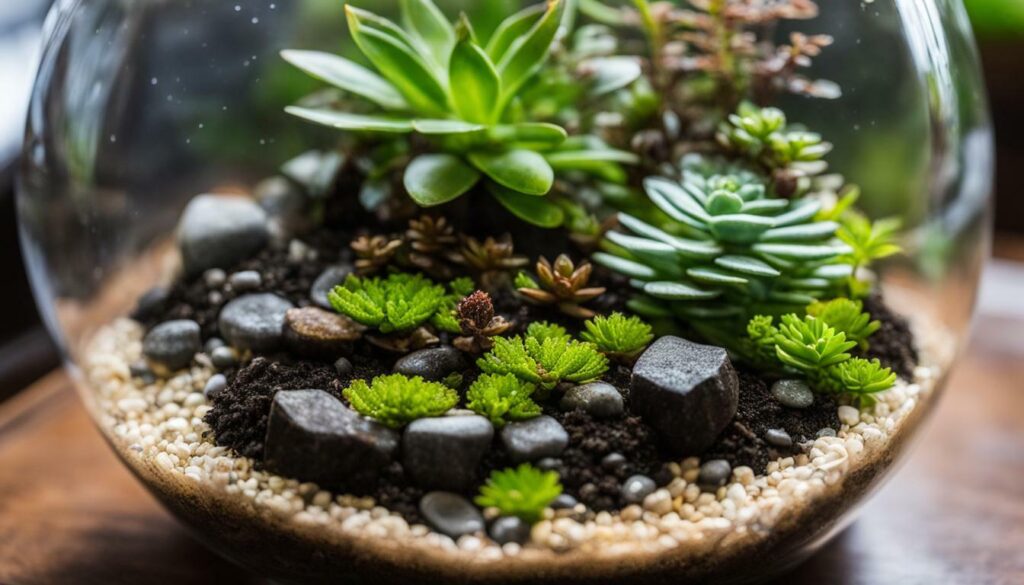
“Preventing mold and fungus in terrariums starts with the right soil care and drainage. Using a well-draining soil mix and monitoring moisture levels are essential. Check for signs like visible fuzzy growth or unpleasant odors, and take immediate preventive measures such as adjusting watering and ensuring proper airflow.”
Preventing Pests in Terrariums
Pests like fungus gnats can be a nuisance in terrariums, but with the right soil selection, care, and ingredients, you can keep them at bay and maintain a pest-free environment. The key to preventing pests in terrariums is to create a healthy and balanced soil ecosystem that supports the growth of your plants while deterring unwanted visitors.
Start by choosing the right soil types for your terrarium. Opt for well-draining soils that allow excess water to flow out easily, preventing the accumulation of moisture that can attract pests. A mix of peat moss, sand, and perlite is often recommended for terrariums, as it provides good drainage while retaining enough moisture for the plants.
In addition to soil types, proper soil care is crucial in pest prevention. Regularly inspect your terrarium for any signs of pests or infestations, such as gnats flying around or tiny white specks on the soil surface. If you spot any, remove the affected plant and replace the soil around its roots. This will help eliminate the source of the infestation and prevent it from spreading to other plants.
Using natural ingredients can also help repel pests in terrariums. Consider incorporating substances like crushed eggshells, cinnamon powder, or neem oil into your terrarium soil. These natural deterrents can help keep pests away without harming your plants or disrupting the delicate balance of the ecosystem.
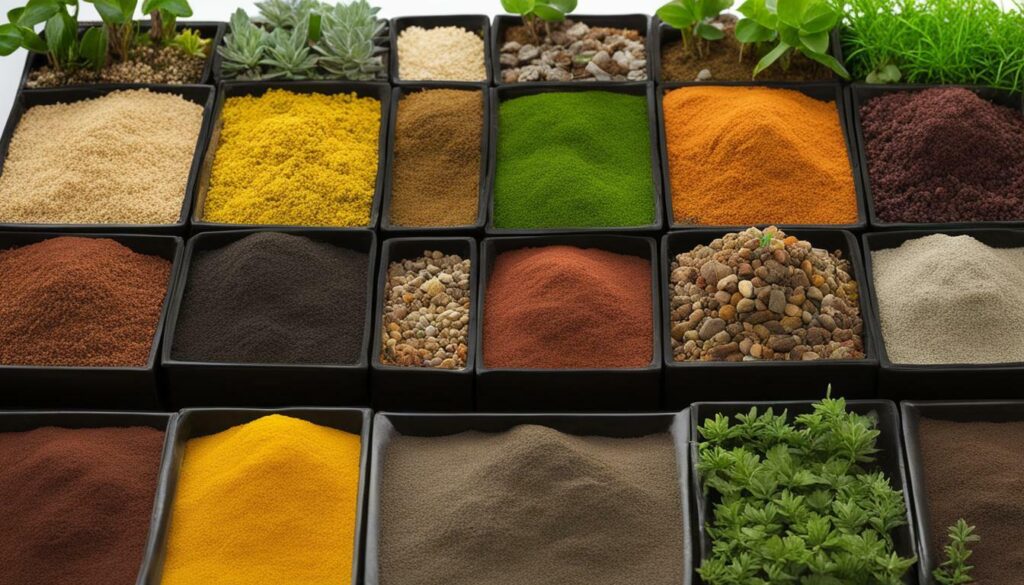
| Pest Prevention Tips |
|---|
| Regularly inspect your terrarium for pests and signs of infestations. |
| Avoid overwatering and ensure proper drainage in the soil. |
| Remove affected plants and replace the soil around their roots if infested. |
| Incorporate natural pest deterrents like crushed eggshells or neem oil into the soil. |
By following these preventive measures and maintaining a vigilant eye on your terrarium, you can ensure a pest-free environment for your plants to thrive and grow.
Maintaining Terrarium Plants
Regular maintenance is essential for the long-term health and vitality of your terrarium plants, and proper soil care plays a significant role in their overall well-being. Terrarium soil care involves monitoring moisture levels and maintaining the appropriate pH balance for optimal plant growth.
When it comes to terrarium soil moisture, it’s important to strike the right balance. Overwatering can lead to root rot and other plant diseases, while underwatering can cause wilting and stunted growth. Be sure to check the moisture levels of the soil regularly by gently pressing your finger into the soil. If it feels dry, it’s time to water your terrarium. If it feels moist, hold off on watering until the soil dries out a bit.
Additionally, monitoring the pH level of the terrarium soil is crucial. Most terrarium plants thrive in slightly acidic to neutral soil conditions. You can test the pH level using a soil testing kit available at garden centers or online. If necessary, adjust the pH level by adding soil amendments or using pH-balancing products specifically designed for terrariums.
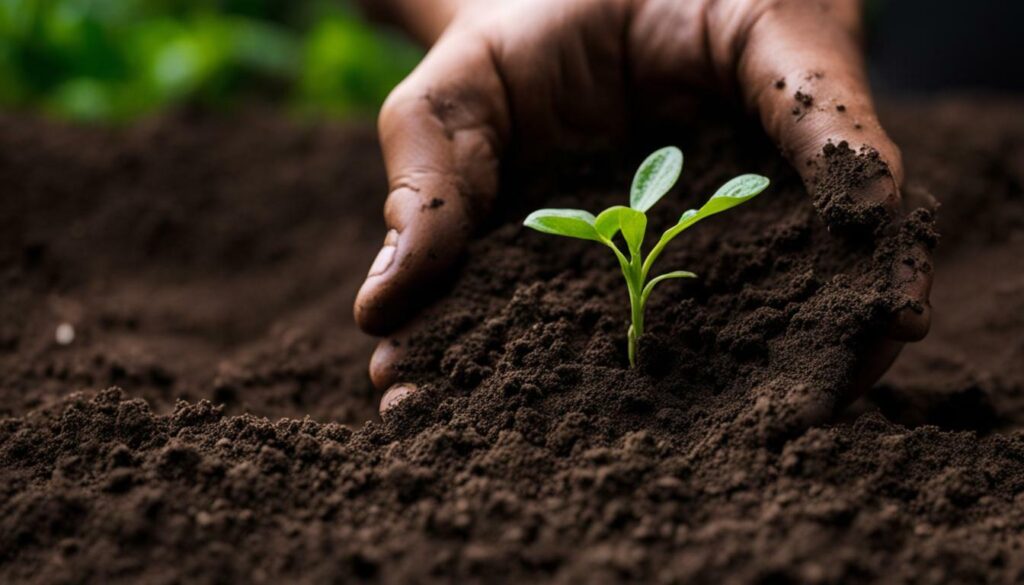
Regularly inspect your terrarium for any signs of mold, fungus, or pests. Mold and fungus can be removed by gently scraping it off the soil surface and improving ventilation within the terrarium. If you notice the presence of fungus gnats or other pests, carefully remove the affected soil from the plant roots and replace it with fresh terrarium soil. This will help eliminate the pest infestation and prevent further damage to your plants.
Lastly, maintaining your terrarium plants also involves regular trimming and removal of dead leaves. Overgrown plants can overshadow their neighbors and cause overcrowding, leading to poor airflow and increased humidity levels. Trim back any overgrown branches or replace larger plants with smaller ones to maintain balance and ensure all plants receive adequate light and airflow.
Summary:
Regular maintenance is crucial for the health of your terrarium plants. Proper soil care, including monitoring moisture levels and pH balance, is essential. Avoid overwatering or underwatering by regularly checking the soil’s moisture content. Adjust the pH level as necessary to create optimal growing conditions. Keep an eye out for mold, fungus, and pests, and take appropriate measures to remove them. Regularly trim overgrown plants and remove dead leaves to maintain a balanced and thriving terrarium. By practicing these maintenance tips, your terrarium plants will flourish and create a beautiful, self-contained ecosystem.
Growing Plants in Terrariums
Terrariums provide an ideal habitat for dwarf, slow-growing plants that thrive in humid conditions and low to medium light, making the selection of the right soil types, composition, and drainage crucial for their successful growth. The type of soil used in a terrarium plays a vital role in providing the necessary nutrients and moisture retention for the plants.
When choosing soil for your terrarium, it’s important to consider the specific needs of your plants. Different plants thrive in different soil types, so research the soil preferences of the plants you want to include. Some popular soil types for terrariums include peat moss-based soil mixes, which provide excellent moisture retention, and cactus soil mixes, which offer good drainage.
To ensure proper drainage, layer the bottom of your terrarium with materials like activated charcoal or small stones before adding the soil. This will help prevent water from pooling at the bottom and potentially causing root rot. Additionally, consider adding a layer of sphagnum moss on top of the soil to aid in moisture retention and create a humid microclimate.
| Plant Name | Lighting Requirement | Soil Preference |
|---|---|---|
| Ferns | Low to medium light | Peat moss-based soil mix |
| Succulents | Medium light | Cactus soil mix |
| Air Plants | Indirect light | Well-draining soil mix |
| Mosses | Low to medium light | Moist and well-draining soil mix |
Remember to monitor the moisture levels and pH of your terrarium soil regularly. Overwatering can lead to root rot, while underwatering can cause the plants to dry out. Aim for a slightly acidic to neutral pH range of 6 to 7 for most terrarium plants. Adjust the watering frequency accordingly based on the moisture needs of your specific plant species.
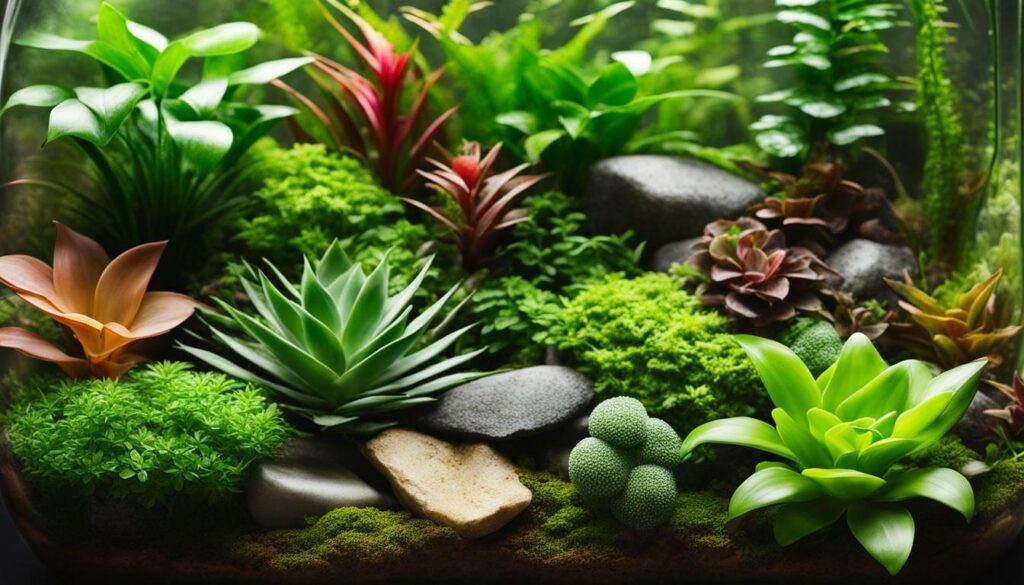
With the right soil, proper drainage, and regular maintenance, your terrarium plants can thrive and create a stunning miniature ecosystem in your home. Enjoy the beauty and tranquility of your terrarium as you watch your plants grow and flourish.
How Does Humidity Control Affect Terrarium Soil Selection and Care?
When it comes to choosing and caring for soil in a terrarium, humidity control in terrariums is crucial. Different plants require different levels of moisture in the soil, so it’s important to select soil that can retain the right amount of moisture based on the humidity control in the terrarium.
Conclusion
Proper soil selection and care are fundamental aspects of terrarium maintenance, ensuring that your plants thrive and create a captivating miniature ecosystem. In order to create a healthy environment for your terrarium plants, it is important to understand the different types of soil and their composition.
When choosing the best soil for your terrarium, consider factors such as moisture retention, drainage, and pH levels. Different plants have different soil requirements, so it is essential to create a terrarium soil mix that suits the specific needs of your plants.
Maintaining the moisture levels in your terrarium soil is crucial for the health of your plants. Regularly monitor the moisture content and adjust watering accordingly. Additionally, be mindful of the pH levels in the soil, as imbalanced pH can negatively affect plant growth.
Mold and fungus can be common issues in terrariums, but with proper soil care and drainage, you can prevent their occurrence. Regularly inspect your terrarium for signs of mold or fungus, and take necessary steps to remove them promptly.
To prevent pests like fungus gnats, choose the right types of soil, practice proper soil care, and use suitable soil ingredients. By implementing these preventive measures, you can ensure that your terrarium remains pest-free and your plants stay healthy.
Regular maintenance is key to the long-term success of your terrarium. Trim overgrown plants and monitor soil moisture and pH levels to create an optimal growing environment. Also, remember to clean your terrarium periodically and remove any dead leaves or debris.
With the right soil, proper care, and attention to detail, your terrarium can be a thriving and captivating miniature ecosystem. Enjoy the beauty and tranquility that these self-sustaining environments provide while watching your plants flourish.
FAQ
What are the different types of soil that can be used in terrariums?
There are several types of soil that can be used in terrariums, including potting soil, peat moss, vermiculite, and sand.
What is the best type of soil for terrariums?
The best type of soil for terrariums is one that is well-draining and retains moisture, such as a mixture of potting soil and sand.
How should I prepare a suitable terrarium soil mix?
To prepare a suitable terrarium soil mix, combine potting soil, peat moss, vermiculite, and sand in equal parts. This will ensure proper drainage and moisture retention for the plants.
Why is proper drainage important for terrarium soil?
Proper drainage is important for terrarium soil to prevent waterlogging and root rot. It allows excess water to drain out, maintaining a healthy environment for the plants.
How should I maintain the moisture levels in terrarium soil?
It is important to monitor the moisture levels in terrarium soil and water accordingly. Avoid overwatering, as it can lead to mold and fungus growth. Adjust the watering based on the condition of the plants and the moisture level of the soil.
How can I deal with mold and fungus in terrariums?
To deal with mold and fungus in terrariums, ensure proper soil care and drainage. Remove any visible mold or fungus, and improve ventilation in the terrarium. Adjust watering to prevent excessive moisture, which can contribute to mold and fungus growth.
How can I prevent pests, such as fungus gnats, in terrariums?
To prevent pests like fungus gnats in terrariums, choose the right soil types, practice proper soil care, and use appropriate soil ingredients. Removing soil from plant roots can help eliminate fungus gnat larvae and prevent infestations.
How should I maintain terrarium plants?
Regular maintenance is important for terrarium plants. Trim overgrown plants to maintain their size and shape. Monitor soil moisture and pH levels to ensure the plants’ health and adjust watering and fertilization accordingly. Remove dead leaves and debris to maintain a clean and healthy terrarium environment.
What types of plants are suitable for terrariums?
Terrariums are perfect for growing dwarf, slow-growing plants that thrive in humid conditions and low to medium light. Some suitable plants include ferns, mosses, air plants, succulents, and certain tropical plants.

